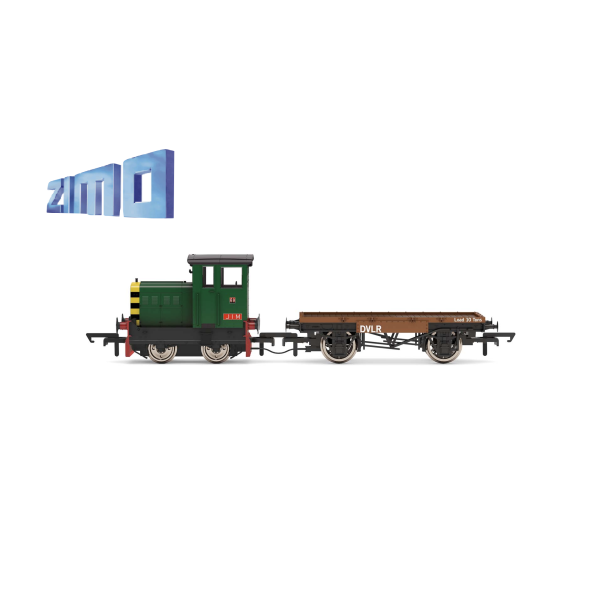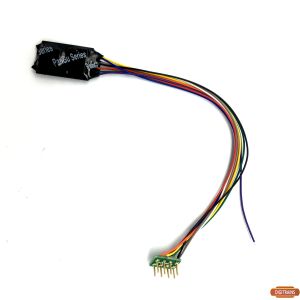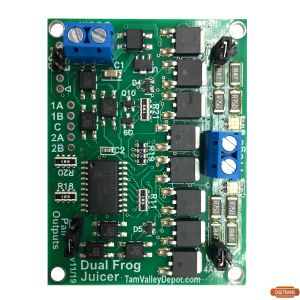ZSRU RUSTON 44/48 SOUNDFILE ZIMO
ZSRU Ruston Hornsby 44_48 sound project for ZIMO decoders V16.07
Please spend a few moments to read these notes which have been produced so that you may obtain the maximum satisfaction from your new sound scheme.
The sounds should work perfectly when the decoder is fitted correctly. Individual locos may require some fine tuning that you can achieve with your DCC controller.
The sounds have been programmed in such a way that you, the user, may change the way that the sounds respond to your driving style or needs. This avoids the need for reprogramming and all the additional costs that would imply.
Throttle Response Scheme.
As supplied, the decoder will produce the sounds of a Ruston Hornsby 44_48 with a train on the hook.
After the start-up routine the loco will stand with the diesel engine ticking over at idle.
The sounds will respond to the throttle control in the following way:
Select speed step required. The engine will increase power to get the loco moving, and will continue at high power. The sounds will spool down to idle on deceleration.
The model can be driven in this way without ever needing to use any control other than the throttle.
You will hear gearbox whine which varies in pitch with actual road speed, not engine speed, to give an indication of acceleration/deceleration.
For something more immersive there are extra control features to further enhance your driving pleasure.
Heavy Train/Light Engine Mode Selection
The default setting is for ‘heavy train’. Inertia is high so acceleration (and deceleration) is restricted.
Activated by F5, Light Engine enables multi-function changes with one key. The switched features include reduced inertia setting to allow more rapid acceleration and engine sounds which are quieter
F5 can be operated at any speed to give another way in which the engine sounds at a given road speed may be modified instantly.
Note. This works best if you switch F5 on or off whilst the engine sounds are playing in idle. Once switched, you can leave it that way, but any further change should also be made with the engine sound again playing the idle loop. Just to be clear, the actual speed is unimportant, but the engine sound must be idling. You can achieve this in several ways as discussed above.
Gear Changing
It’s possible to simulate gear changes quite easily as follows.
When the engine achieves a steady power sound, reduce the speed steps by 1 (or more) and the engine will spool down to idle.
Any subsequent increase in speed steps (1 or more) will cause the engine to rev up again.
Working Brakes
F key 2 will apply the working brake feature. F2 can either be ‘dabbed’ or held for varying durations.
However, if the throttle is reduced first, as a real driver would do before braking, a braking force will be applied which will continue to increase the longer F2 is held. Short dabs will provide speed trimming, held down continuously will result in a controlled ‘Emergency Stop’.
Brake squeal will play automatically just prior to the loco finally stopping. This can be adjusted within the project if required.
Tip: F5 temporarily reduces the value in CV4 to simulate Light Engine levels of momentum. Using F5 when in Heavy mode will shorten stopping distances.
Mute
F key 19 provides a ‘Fade to Mute’ function. When engaged, all sounds will fade to silence; when disengaged sound will return to previous volume setting by fading in.
Live Volume Control
Provided the sound is switched on and the ‘fade’ button is not active, it is possible to change the overall volume to suit changing needs.
Engage F27 and the sound levels will gradually reduce, eventually to silence
Engage F28 and the sound levels will gradually increase, eventually to maximum.
In each case, disengage the F key when the desired level is attained. Set F27 and F28 as ‘momentary’ if your DCC controller allows you to do so.
Note: If the volume controls appear to not function, check that F27, 28 and F19 are disengaged before making a further attempt.
It’s now down to your skill and knowledge to simulate any eventuality!
Function List
|
F Key
|
Function/Sound
|
Latch/
Momentary
|
Sound
CV
|
Volume
CV
|
Loop
CV
|
|
0
|
Lights (if fitted)
|
L
|
570
|
571
|
572
|
|
1
|
Sound On/Off
|
L
|
513
|
514
|
515
|
|
2
|
Brake Key (no sound)
|
M
|
516
|
517
|
518
|
|
3
|
Horn
|
M
|
519
|
520
|
521
|
|
4
|
Very Short Toot
|
M
|
522
|
523
|
524
|
|
5
|
Light Engine Mode
|
L
|
525
|
526
|
527
|
|
6
|
Horn (Short Duration)
|
M
|
528
|
529
|
530
|
|
7
|
Horn (Medium Duration
|
M
|
531
|
532
|
533
|
|
8
|
Bogie Flange squeal
|
L
|
534
|
535
|
536
|
|
9
|
Flange Squeal
|
L
|
537
|
538
|
539
|
|
10
|
Skip Coupling
|
M
|
540
|
541
|
542
|
|
11
|
Despatch Whistle
|
M
|
543
|
544
|
545
|
|
12
|
Sand Box
|
L
|
546
|
547
|
548
|
|
13
|
‘Clear’
|
L
|
549
|
550
|
551
|
|
14
|
Horse Whinny
|
L
|
552
|
553
|
554
|
|
15
|
Sheep
|
L
|
555
|
556
|
557
|
|
16
|
Truck start and drive off
|
M
|
558
|
559
|
560
|
|
17
|
Klaxon
|
M
|
561
|
562
|
563
|
|
18
|
Klaxon
|
M
|
564
|
565
|
566
|
|
19
|
Fade All Sounds
|
M
|
567
|
568
|
569
|
|
20
|
Reserved
|
-
|
673
|
674
|
675
|
|
21
|
Reserved
|
-
|
676
|
676
|
678
|
|
22
|
Reserved
|
-
|
679
|
680
|
681
|
|
23
|
Reserved
|
-
|
682
|
683
|
684
|
|
24
|
Reserved
|
-
|
685
|
686
|
687
|
|
25
|
Reserved
|
-
|
688
|
689
|
690
|
|
26
|
Reserved
|
-
|
691
|
692
|
693
|
|
27
|
Volume Down
|
-
|
694
|
695
|
696
|
|
28
|
Volume Up
|
-
|
697
|
698
|
699
|
The table shows the project defaults; you can always return to these by programming CV8 = 8.
The Momentary/Latching column shows my recommendation if your DCC system allows you to assign this choice to that F key.
The Sound CV Column shows the CVs which contain the sound for the respective F keys.





